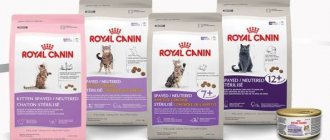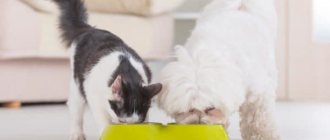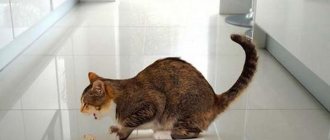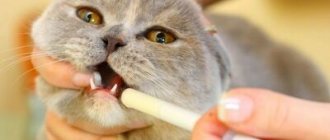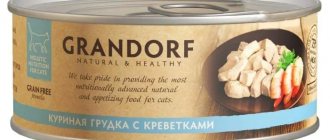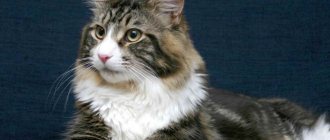Home » Interesting collections about animals
How many times a day should you feed your cat?
For cats of different breeds , as for any other pets, it is extremely important to eat properly, measuredly and nutritiously.
The planned diet must be strictly followed, since timed meals have a beneficial effect on the health, behavior and well-being of the pet.
A well-fed animal behaves more balancedly
The better the animal’s feeding schedule is calculated, the fewer problems arise with its behavior and overall health.
This is explained by the fact that the pet gets used to eating from its own bowl at a certain time, and is not afraid of being hungry.
Therefore, the cat will not beg every time he watches his owner eat.
- 2 How many times a day should you feed your cat?
- 3 How to feed a cat correctly?
How much dry food does a cat need per day?
A cat needs calories, not grams, and the energy requirement depends not on body weight, but on body surface area. Therefore, the assumption that a 2 kg pet will need twice as much food as a 1 kg animal is incorrect. In addition, activity must be taken into account.
A cat that walks outside needs more than a pet that spends its entire life in an apartment. In hot weather, the need for energy decreases, in cold weather it increases.
A growing kitten needs more calories per unit of weight, and therefore more grams, than an adult pet. The needs of pregnant animals of all types increase by a third, and nursing mothers by 3 times. An obese cat needs to reduce the daily portion, while an exhausted cat needs to increase it.
If the cat is unwell, veterinary food is used, the consumption of which is strictly regulated. Therefore, when calculating the required amount of dry food, a combination of factors must be taken into account.
Human baby food
Often, owners start giving their pets baby food, considering it a good option for a healthy diet. They especially like to feed it to kittens and old cats that have serious problems with their teeth and stomach.
It is impossible to say that this is bad food, but when choosing it, you should take into account a number of features.
- Percentage in the diet. Baby food should not be used as the main food. It can make up no more than 20% of the entire diet. The exception is when the pet is seriously ill and cannot, due to its condition, consume anything else.
- Compound. Cats are not able to fully digest plant foods. Because of this, when choosing baby food for them, you need to purchase only meat puree without vegetable additives. A high-quality product is usually expensive, and therefore there is no point in replacing cat food with it unless absolutely necessary.
- Age of the cat. For an adult pet that has no health or dental problems, baby food is just a treat, not a necessity. For kittens, such an addition to the diet, if it is planned to keep them on natural food in the future, will facilitate the transition from mother's milk to adult food. For old animals with a number of pathologies, baby food is the only option.
Fermented milk products are good for cats. Children's curds without added sugar are a good option for them at any age. They are balanced in fat content and do not contain preservatives. Adult cats, with a normal state of the digestive system, can eat regular cottage cheese, but for kittens, children's cottage cheese is more suitable.
It is not advisable to dilute dry baby food with water for your pet. A cat is a predator by nature, so it requires substances other than those contained in it.
How many grams of dry food should I give my cat per day?
Feed manufacturers print on the packaging how much feed to give to animals of different weights and fatness. So, for a cat weighing 5 kg below average body condition, 76 g of Royal Canin Satiety Weight Managements dry food per day is required.
Be sure to read:
Is it possible to feed a cat dry and wet food at the same time: rules, pros and cons A
normal-condition pet is given 63 g, an obese one 50. Taking into account the individual characteristics of the animal, you can adjust the consumption down or up within ±10%.
What should a nursing cat's diet be?
The cat will be the kittens' only source of food for the first eight weeks of their lives. During breastfeeding, the need for food increases up to 4 times. At the pet store you can buy food for nursing cats; this product is rich in proteins, vitamins and minerals necessary for full milk production. Of course, when choosing ready-made food, you need to make sure that it does not contain harmful chemical additives.
You can also offer kitten food to a nursing cat. For example, Iams kitten, Pro plan kitten or Baby cat from Royal Canin. Such products are very nutritious and fully satisfy the increased need for calories. These foods do not contain artificial flavors. The frequency of feeding depends on the needs of the cat itself and the capabilities of the breeder.
Iams kitten
Some people prefer to leave cat food freely available; this is an undeniable advantage of dry food, since it does not spoil. Other owners feed the cat on demand.
Many increase the frequency of feeding several times. It is difficult to unequivocally answer the question of which approach is correct, because even veterinarians have not come to a consensus on this matter.
Feeding wet industrial feeds
In some cases, the cat is recommended to consume factory-prepared wet food. This is necessary when the cat has difficulty chewing granules, is recovering from an illness, or needs dietary nutrition. Finally, cats eat wet food more readily than dry food. Therefore, they can be given to diversify the diet or as a reward treat.
Wet food is produced in bags or jars, with a humidity of 80% or 64%. When replacing dry food with wet food, take into account that in terms of dry matter content, 1 g of granules corresponds to 2.5 g of canned food or 4.5 g of pouch contents. When purchasing wet food, you need to keep in mind that an opened can or pouch can be stored in the refrigerator for no more than 36 hours.
How to calculate the daily feeding rate for cats and cats
The consumption rate of dry food for adult animals depends on the physiological state, activity, and nutritional status. If the cat has a visible waist, the ribs and pelvic bones are not visible, but they are easy to feel, the chest and abdomen are covered with a thin layer of fat, the cat has normal fatness. If the waist cannot be seen, the ribs and pelvic bones cannot be felt, a layer of fat is felt on the abdomen - the cat is overweight.
It is more difficult to determine the condition of a long-haired cat; you have to pay more attention to palpation. The table shows the approximate amount of dry food in grams for cats of different weights and fatness, aged from 1 to 7 years, living indoors.
| Weight kg, fatness | 2,5 | 3,5 | 4,5 | 5,5 | 6,5 |
| Normal | 39 | 51 | 61 | 71 | 80 |
| Excessive | 31 | 40 | 48 | 56 | 63 |
Optimally suitable menu
Natural nutrition
How much and how to feed a cat depends not only on the age and physiological state of the animal, but also on the energy value of the food or natural products from which Murka’s diet is based. Typically, the average cat for every kilogram of weight should receive:
- at least 10 g of protein,
- up to 2 g fat,
- up to 3 g of carbohydrates (of which up to 0.4 g should be fiber)
- and various vitamin and mineral baits and supplements.
How much food a cat needs per day can be seen in the table (when feeding natural products - g/day):
| Product type | Adult cats | Kittens | ||||
| up to 1 month | 1-3 months | 3-6 months | 6 months and > | |||
| Meat and meat by-products | 80-120 | 8-10 | 10-60 | 60-80 | 80-100 | |
| Fish | 80-100 | 6-8 | 8-50 | 50-60 | 60-80 | |
| Milk | 100-200 | 20-30 | 30-100 | 100-130 | 130-150 | |
| Cottage cheese | 30-50 | 3,5 | 5-10 | 10-15 | 15-20 | |
| Groats | 50-80 | 10-20 | 20-50 | 50-70 | 70-80 | |
| Vegetables | 30-40 | 10-15 | 15-20 | 20-30 | 30-40 | |
| Animal fat | 5-8 | 1 | 1-2 | 3 | 3-4 | |
| Flour | meat and bone | 10-15 | — | 5-8 | 8-10 | 10-12 |
| fish | 8-12 | — | — | 3-5 | 3-5 | |
| bone | 8-10 | 1-2 | 2-5 | 5-7 | 7-8 | |
| Fish fat | 1,3 | 0,5 | 0,5-1 | 1-1,5 | 1-1,5 | |
| Chicken eggs, pcs. | 1-2 per week | |||||
Depending on the general needs, cat owners can create the menu for their pets themselves.
A few simple recipes for nutritious feeding:
- 1 recipe . Cook separately 2 kg of meat (beef, poultry, rabbit, turkey), 200 g of buckwheat or rice, up to 500 g of vegetables (turnips, broccoli, bell peppers, carrots). Grind everything through a meat grinder, season with olive oil (no more than 2 tablespoons) and a small amount of weak broth after cooking the meat. The resulting mixture is divided into portions (by weight it is good to correspond to 1 feeding) and frozen. This mixture is enough to feed an adult cat weighing up to 5 kg for a week.
- 2 recipe . Raw 150-200 g of vegetables, 1 kg of raw chicken fillet and up to 150 g of boiled rice are passed through a meat grinder. Meatballs are formed, boiled in boiling water for 10-15 minutes, cooled and frozen.
- 3 recipe . Cut into medium-sized pieces: 700 poultry or beef (50/50 is possible), 200 g chicken or beef hearts (an excellent source of taurine), up to 100 g liver (no more). Everything is filled with ½ cup of natural fiber and seasoned with 2 chicken yolks. The mixture is frozen in portions. Feed daily according to natural feeding standards. Be sure to defrost before serving.
You can create different quantities of such recipes yourself. In addition to the listed products, your diet should contain 20-30 grams of fermented milk products (kefir, fermented baked milk, low-fat cottage cheese) every day. Vitamin and mineral supplements can and should be added to the composition.
How much natural food should a cat eat? It should be no more than 7-7.5% of the cat’s total body weight.
| Cat weight | The daily portion of natural food should not exceed |
| With a cat weighing 4 kg | up to 300 g. |
| for pregnant | up to 350 g. |
| old cats | up to 200 g |
| kittens | 50-100 g. |
Of course, the figure is approximate and can vary in one direction or another, depending on the physiological state of the animal (illness or recovery from it, pregnancy, feeding kittens with breast milk, old cats, etc.).
When feeding natural products, the amount of water the cat drinks is from 70 to 80 ml .
Effect of feed classes
There are economy, premium and super premium food. The last category of ready-made food contains meat, vegetables, and fully meets the nutritional needs of cats. They produce food that takes into account age, gender, and dietary food for sterilized cats and pets of all ages, from kittens to older adults. Economy class meals do not have a wide range of options.
The class of feed has little effect on palatability. Pet owners may find that their pets' output increases and their odor increases when switching to a frugal diet. The coat does not shine, the animal may gain excess weight. An unbalanced diet has a negative impact on the liver and kidneys; the pet ages faster and develops chronic diseases.
Be sure to read:
Can cats have sweets: when is it necessary, in what form is it allowed, benefits and harms, why not?
Super premium food is high in calories, so cats need less kibble to fill them up. So, for an adult pet weighing 4 kg, Royal Canin manufacturers recommend giving 55 g per day; manufacturers Kitiket 63.
How to make a cat's diet
First of all, a cat's feeding schedule depends on the type of diet that the owner prepares for him.
So, there are three common diets for cats:
- Human food from the table
- Natural food;
- Feed.
Food from the table
Many people who feed their pet food from their table do not even realize that they are greatly harming this animal.
Doing this is strictly prohibited, since the cat’s body suffers from many dishes and products that are usually consumed by humans.
Such “harmful” foods for animals include:
- Salty;
- Roast;
- Pickled;
- Sweet;
- Baked;
- Food with spices.
Cats often ask for human food, which is harmful to them
By consuming these categories of food from the human table, the cat gradually acquires health problems.
First of all, the following organs of the animal’s body are affected:
- Liver;
- Kidneys;
- Stomach;
- Intestines.
These problems require serious, sometimes surgical, treatment, which lasts quite a long time.
In addition, the process of treating a cat is stressful for it, and for the owner it is quite expensive.
Natural food
There is no consensus among veterinarians and breeders about what exactly is best to feed a cat - natural food or professional food.
This is explained by the fact that by choosing the right natural food for an animal, you can achieve a good balance of the nutrients it needs.
Consequently, the choice of whether to feed the cat natural food remains with the owner.
It depends on the time he has and the amount of money he is willing to spend on feeding his pet.
The healthiest meats for cats to eat are beef, turkey, chicken, duck and rabbit.
Natural food gives the animal an important feature - variety in the diet.
But proper preparation and menu preparation takes quite a lot of time, and at times, it is also more expensive than buying ready-made food .
In any case, you should not mix natural food with industrial food.
In addition, there are several foods that should not be given to cats.
These include:
- Onion;
- Pork;
- Chocolate;
- Mushrooms;
- Salt;
- Raw eggs;
- Raw fish;
- Garlic.
By the way, raw and boiled eggs, raw fish and milk can be given to the animal occasionally.
The cat owner must clearly understand that these animals need a lot of protein.
They need it five times more than, for example, dogs.
This is why you should not feed your cat dog food if there are several types of pets living in the house.
Many cat lovers know that cats are picky eaters.
They may refuse to eat a particular dish out of pickiness.
To know more precisely what your cat will like, you need to experiment and make high-protein dishes, including protein sources such as:
- Chicken;
- Turkey;
- Beef;
- Rabbit;
- Duck.
By alternating or combining different protein foods in one dish, you can achieve a complete balance of nutrients and enrich your diet with a variety of tastes and textures.
Chocolate is a prohibited food for cats.
There are several foods that are highly desirable to include in a cat's diet:
- Heart. This organ is very useful for cats and includes taurine, an essential acid that is required for the full functioning of the body of these animals.
- Kidneys;
- Liver;
- Spleen;
- Brown rice;
- Pumpkin;
- Spinach;
- Carrot.
Brown rice is the best source of carbohydrates for a cat's body.
Feed
It is worth remembering that cat food is food made specifically for furry pets.
It includes the necessary components, vitamins and microelements that the animal needs to saturate the body.
There are three classes of cat food that differ in quality and price:
- Economy
Feeds of this class include Darling, Whiskas , and Friskies.
They are also made with relatively cheap ingredients, such as meat by-products, soy, preservatives, dyes, and flavor enhancers.
It is worth noting that practically no vitamins are added to such foods, and they are low in calories.
When giving this food to a pet, the owner must understand that the animal is unlikely to get enough of the usual portion.
In addition, in this case it is necessary to give the pet vitamins and minerals in the form of an additional supplement.
- Premium
When producing this class of food (“MeowMix”, “Cat Chow”, “ Sheba ”, “ Leonardo ”), the manufacturer uses natural meat and offal.
Vegetable protein is used - corn and preservatives.
It also does not contain enough vitamins and minerals, so they need to be given additionally.
Royal Canin is one of the most vitamin-rich cat foods
- Super premium
These foods, which are produced by such brands as Royal Canin , Hills , Nutra Mix, Ekanuba , Bozita , contain natural meat, a vitamin complex, as well as a list of minerals and fatty acids.
This class of food contains vitamin E as a preservative, which makes the food related to it significantly more useful compared to less expensive ones.
How to measure a portion?
When purchasing food at a pet store, you should purchase a measuring cup, one for each type of food. Granules have different volumes and densities. Kitchen scales are not suitable: 30-40 g cannot be weighed on them. You can measure the contents of a pack of food using disposable cups, make a mark, or ask the seller to weigh the portion. D
You can purchase a measuring cup for Royal Canin. It is divided into 1/8 portion marks, corresponding to 15 g of kibble. Therefore, a 4 kg cat needs 55 g or 4/8 of a cup.
When he was born
Feeding a newborn kitten is perhaps the only topic in nutrition that does not concern you at all.
His mother knows the answer to this question. But it happens that people also have to feed babies, for example, foundlings.
So what do you need to know if a baby is dropped at your door, or for some other reason, feeding a kitty falls on your shoulders.
- A newborn cannot drink on his own, so you need to stock up on an ordinary medical syringe.
- Formulas for newborns are sold especially for refuseniks. Just like people. This mixture has a composition as close as possible to the composition of milk from a nursing cat. You can buy it at a pet store
- If you can’t buy the mixture, the food can be prepared at home. Goat and cow's milk are mixed in equal proportions, then egg white is added. The resulting mixture is filtered and heated to 30 degrees
- In order for the baby to be full, he needs to be fed every 2 hours, day and night.
A signal that the baby is completely full will be his quiet sleep. If after feeding the baby squeals, then eating should be continued.
Feed intake depending on age and activity level: table
The average requirement for dry granules depends on the age and weight of pets and is shown in the table.
| Age, months |
For each type of feed, manufacturers provide their own tables, which may differ from the given values. A growing body needs an increased amount of calories; after six months, the need for energy decreases.
If we take as the standard the amount of food recommended for cats walking outside, then pets living in a high-rise building will need 20% less, and hyperactive creatures, for example, Maine Coons, will need the same amount more.
How to support the old one
The average lifespan of cats is 12 years. At the age of 8 years, the pet is already called senior. The cat's body begins to age early, and irreversible changes occur in it, leading to the need to reconsider its diet. Food manufacturers have special product lines for older and elderly cats. They include everything necessary to maintain health and prevent the appearance of many age-related disorders.
Natural feeding should be adjusted for cats entering old age. The basis of their diet is beef, and chicken is given occasionally. The meat is first boiled or scalded. To speed up digestion and prevent constipation, you need to add a little bran to meat or porridge once a day. To avoid age-related problems with bones, it is necessary to increase the calcium content in the diet, for which low-fat cottage cheese is given 3 times a week. Vegetables continue to be included in meals as before. Boiled offal is given in ground form.
Fish is contraindicated for older cats, as it leads to the development of urolithiasis in them.
For older pets, certain feeding requirements must be observed. With age, the digestive system of cats begins to work weaker, and it is necessary to treat it more delicately. Because of this, the daily amount of feed should be divided into at least 4 feedings. It is important to work with your veterinarian to select vitamin and mineral supplements that will support the body. Due to dental problems, an older cat may begin to refuse solid food. In this case, you will need to replace it with a soft one or grind it.
Cat without teeth
How much food to give a cat per day with a mixed diet?
Some owners practice mixed feeding with granules and wet food. It is known that a spider weighing 100 g approximately corresponds to 22 g of dry food. If a cat is offered one pouch per day, then the amount of dry food is given in accordance with the table.
| Weight kg, fatness | 2,5 | 3,5 | 4,5 | 5,5 | 6,5 |
| Normal | 17 | 29 | 39 | 49 | 58 |
| Excessive | 9 | 18 | 26 | 34 | 41 |
For large pets, you can use a scheme with two spiders. In this case, the cat needs the following amount of granules:
Be sure to read:
When to start feeding kittens: how to introduce them, diet, what not to feed, age for first feeding
| Weight kg, fatness | 5,5 | 6,5 |
| Normal | 27 | 36 |
| Excessive | 12 | 29 |
How much dry food does a cat need after castration?
Sterilized cats require specialized nutrition, otherwise the pet will develop urolithiasis. Therefore, you need to purchase food for sterilized cats.
They contain moderate amounts of fat and protein, a minimum of carbohydrates and a high concentration of dietary fiber - natural limiters of consumption. Since the absence of gonads reduces motivation for an active lifestyle, they focus on the norms for cats with reduced activity.
However, even in such cases, cats manage to gain weight due to adynamia. It is known that boredom increases the appetite of an animal or a person. Therefore, for a neutered pet, they buy toys that will distract them from gluttony. It is necessary to regularly assess the condition of animals and reduce the portion when excess weight accumulates.
The right utensils for feeding
When choosing a dish for your cat to eat from, it is better to give preference to a shallow plate with wide edges. If the container is small in diameter or has high edges, this will cause discomfort while eating, as the whiskers will cling to the edges of the plate. Cats' whiskers are an organ of touch, a kind of sensor with which they navigate in space.
To optimize the feeding process, you can use automatic or electronic feeders. They have the ability to customize for a specific feeding time and portion size.
You should not blindly and unconditionally follow the rules and recommendations when creating a menu for your pet. Each of them is unique and inimitable, with its own characteristics and preferences. Careful observation of the cat, its reaction to different products or industrial feeds will allow you to choose the most suitable feeding option.
How often should you feed your cat?
The number of feedings depends on the age of the pet. A healthy kitten up to two months old needs 6 feedings. The number of splits of the daily portion is gradually reduced to two, unless the veterinarian prescribes otherwise.
If the owner is not at home for several days, measure out the amount of necessary food with a reserve of 15-20% and provide free access to drink. Fasting for two or more days should not be allowed, so as not to provoke a life-threatening disease - liver lipidosis.
Principles of organizing a proper diet
If the owner has doubts about when and how often to feed the pet, it is worth adopting several techniques for optimally organizing cat dinners, which are recommended by veterinary experts.
Following these rules will help avoid digestive problems and protect against the development of obesity:
- Two feedings throughout the day is the answer to the question of how many times a day you need to feed your pet kitty. It is preferable to do this in the morning and evening. Please note that an adult cat should be fed according to this regimen. A small kitten should be fed five to six times during the day. They are transferred to two meals a day after six months of life.
- Feeding at the same hours. This rule disciplines the cat; he does not get used to begging from the master's table.
- Limiting feeding time. It takes a cat 20 minutes to satisfy his hunger and get enough. If during this time he has not eaten all the food, it is still better to remove the bowl of food. This will help avoid unnecessary overeating. If the cat begins to lazily eat the rest of the food, it means that he is already full enough.
- Single serving limit. You should not add a daily portion of food at one feeding.
Regardless of the time and number of feedings, fresh water should always be fully available to the cat.

